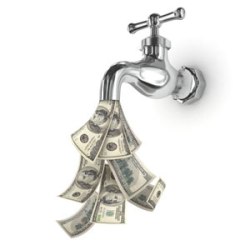
Cash flow crisis is the primary reasons most small businesses fail. If you don’t watch cash flow like a hawk your business will end up in trouble sooner rather than later, and in many cases this may prove fatal. Nevertheless, many small businesses will encounter cash crunch at some point in their existence. How you deal with can determine whether your business will be able to survive or meet the graveyard. The immediate action you need to take when facing cash flow challenge is to find found sources that can provide cash on a short-term basis and help you meet your cash obligations to your creditors and employees. Below we describe 7 options you can explore to find cash needed to keep your business going.
- Sale of Surplus or Slow-Moving Stock
- Reduce Expense and Self-Financing
- Sell, Downgrade and Lease Vehicles
- Sale of Other Assets
- Bank Loans
- Partners and Investors
- Personal Loans
The ideal way to manage a cash flow crisis is through internal funds and the fastest and often least painful way to do that is via inventory sale. A sale on surplus and slow-moving stock is particularly appealing because the long-term potential on that inventory was not particularly good anyway. An alternative to a sale is vendor buyback, which many vendors will agree to in order to help a business survive.
Another form of internal funding is self-financing. The easiest way to self-finance is to reduce expense, which then increases cash flow. If expense reduction alone is not enough, then the cash flow can be augmented from personal savings and other assets. The benefit to this approach is that the long-term penalties will be small or even non-existent. Keep in mind, however, that this can be a risky proposition with potential legal ramifications.
Selling or downgrading vehicles is different from other assets because a business owner can often sacrifice convenience and luxury while maintaining functionality. For instance, a company could sell owned vehicles for fast cash flow and meet its needs through lease that have low up-front costs.
The benefit of a sale is that the company can still generate a profit. Sometimes, however, it may even be necessary to break even or accept a long-term loss in order to generate the cash flow required now. For instance, a company might sell an asset, such as tools or equipment, in spite of knowing that it will have to one day buy that asset back again and thus lose money in the process.
Perhaps the most traditional way to supplement cash flow during a crisis is through financing from a financial institution, such as Clydesdale Bank. This may even be the best funding option for an otherwise healthy business that is simply dealing with minor challenges from an unforeseen market condition. Business loans, however, are based on financial forecasts, and that means that they will not be practical for a struggling company.
Finding investors may be more practical option compared to bank loan because investors will be willing to temper their gains with the needs of the business. Investors are also a good option when the needed terms are simply too long for a traditional bank loan. You pay the price by relinquishing, at least partial, control, and that may change the business in a likely irrevocable way.
Finally, some small businesses can turn to family and friends for a personal loan that is then transferred to the business. Unfortunately, such agreements can put a great strain on friendships and family relationships and can be emotionally tricky since they generally require a formal written agreement in order to protect the lender, the borrower and the business.
What other sources of funding would you recommend for business going through cash flow crisis?






